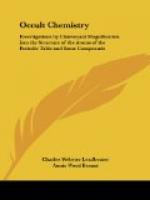On raising the gaseous atom to E 4, the falling away
of the wall sets free the six contained bodies, and
both the balloon and the egg round themselves, apparently
with the removal of their propinquity, as though they
had exercised over each other some attractive influence.
The smaller bodies within the egg—marked
q on E 4—are not on one plane, and
those within n and o form respectively
square-based and triangular-based pyramids. On
raising all these bodies to E 3 we find the walls
fall away as usual, and the contents of each “cell”
are set free: p of E 4 contains six small
bodies marked k, and these are shown in k
of E 3, as containing each seven little bodies—marked
e—each of which has within it two
ultimate atoms; the long form of p E 4—marked
l—appears as the long form l
on E 3, and this has three pairs of smaller bodies
within it, f’, g and h,
containing respectively three, four and six ultimate
atoms; q of E 4, with its seven contained particles,
m, has three particles m on E 3, each
showing three ultimate atoms within them; e
from n of E 4 becomes i of E 3, with
contained bodies, e, showing two ultimate atoms
in each; while e’ from o of E
4 becomes j of E 3, each having three smaller
bodies within it, e’, with two ultimate
atoms in each. On E 2, the arrangement of these
ultimate atoms is shown, and the pairs, f’,
g and h are seen with the lines of force
indicated; the triads in f—from m
of E 3—are similarly shown, and the duads
in e and e’—from i
and j of E 3—are given in the same
way. When all these bodies are raised to E 1,
the ultimate physical atoms are set free, identical,
of course, with that previously described. Reckoning
up the number of ultimate physical atoms in a chemical
atom of nitrogen we find they amount to 261, thus divided:—
62 + bodies with 2 ultimate
atoms, 62 x 2 = 124
24 — " " 2 " "
24 x 2 = 48
21 — " " 3 " "
21 x 3 = 63
2 + " " 3 " " 2 x 3
= 6
2 + " " 4 " " 2 x 4
= 8
2 + " " 4 " " 2 x 6
= 12
——
261
This again approaches closely the weight-number assigned
to nitrogen:—
261 / 18 =14.44 +
This is interesting as checking the observations, for weight-numbers are arrived at in so very different a fashion, and especially in the case of nitrogen the approximation is noteworthy, from the complexity of the bodies which yield the number on analysis.




